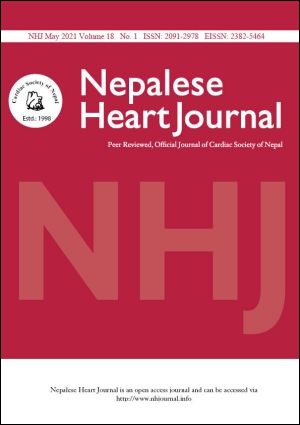Trends and Profile of Permanent Pacemaker Implantation in Nepal. Experience From Tertiary Cardiac Center (SGNHC) From 2001 to 2020.
DOI:
https://doi.org/10.3126/njh.v18i1.36778Keywords:
Nepal, Permanent PacemakerAbstract
Background and Aims: The number of pacemaker implantation is increasing at various centres of Nepal with increase in cardiac services. However, there are few data available regarding the pacemaker implantation in Nepal. This study intend to focus and study trends and profile of permanent pacemaker implantation (PPI) of 19 years experience at the referral tertiary cardiac center which will reflect intended objective of this study.
Methods: This was a retrospective cross sectional study done at Shahid Gangalal National Heart Centre (SGNHC). The data of the patient who underwent PPI from 2001 November to 2020 August were reviewed. Patients data including age, sex, indication for pacing, mode of pacing, type of pacemaker implanted, implantation parameters such as lead impedence and threshold were recorded and analyzed.
Results: A total of 3631 pacemaker implantation were performed at SGNHC from 2001 November to 2020 August. Among the total patients, 59.4% were male with mean age of 65.2±15.2 years. The most common indication was degenerative complete heart block (74.8%). Sick sinus syndrome (8.2%) was the second most common indication of pacing. The single chamber were implanted in 93.3% cases and dual chamber in 6.7% cases. VVIR was the most common mode of implantation in 93.1% cases, followed by DDDR (6.7%). AAIR (0.1%) and VDD in 0.1% cases. The total number of pacemaker implanted yearly in SGNHC has increased since the early year of implantation. During the early years most of the pacemakers were Single chamber (VVI) pacemaker and the implantation of dual chamber pacemaker increased gradually from year 2010 onwards. After the year 2010 the implantation of dual chamber pacemaker has increased significantly compared to prior to 2010 (p= 0.001). There were no gender differences in use of single chamber and dual chamber implantation during this period. (p value = 0.489). The dual chamber were implanted mostly in age group less than 65 year compared to more than 65 years (P value = 0.001).
Conclusion: There is gradual increase in the number of pacemaker implantation yearly at SGNHC and since 2010 there is also increase in number of dual chamber pacemaker implantation though the single chamber pacemaker outnumbered the dual chamber implantation.
Downloads
Downloads
Published
How to Cite
Issue
Section
License
This license enables reusers to distribute, remix, adapt, and build upon the material in any medium or format, so long as attribution is given to the creator. The license allows for commercial use.




